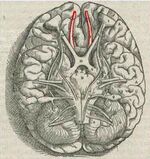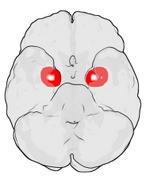(→Clinical implications: Parosmia) |
No edit summary |
||
| (One intermediate revision by the same user not shown) | |||
| Line 1: | Line 1: | ||
{{BioPsy}} |
{{BioPsy}} |
||
| − | The '''olfactory system''' is the [[sensory system]] used for [[olfaction |
+ | The '''olfactory system''' is the [[sensory system]] used for [[olfaction]]. |
==Anatomy== |
==Anatomy== |
||
| Line 10: | Line 10: | ||
**[[Olfactory nerve]] |
**[[Olfactory nerve]] |
||
*In the brain |
*In the brain |
||
| + | **[[Olfactory cortex]] |
||
**[[Olfactory bulb]] |
**[[Olfactory bulb]] |
||
**[[Piriform cortex]] |
**[[Piriform cortex]] |
||
**[[Amygdala]] |
**[[Amygdala]] |
||
**[[Entorhinal cortex]] |
**[[Entorhinal cortex]] |
||
| + | |||
| + | *[[Olfactory nerves]] |
||
| + | *[[Olfactory pathways]] |
||
| + | *[[Olfactory tracts]] |
||
| + | *[[Olfactory cells]] |
||
| + | *[[Olfactory mucosa]] |
||
| + | *[[Olfactory trigone]] |
||
| + | *[[Olfactory glands]] |
||
| + | *[[Olfactory tract]] |
||
| + | *[[Olfactory sensory neuron]] |
||
| + | |||
| + | |||
| + | |||
| + | |||
| + | |||
| + | The are linked to [[olfactory receptors]] that bind with [[aroma compounds]] and provide the signals that give the experience of [[odor] |
||
==Function== |
==Function== |
||
| Line 31: | Line 48: | ||
==Clinical implications== |
==Clinical implications== |
||
Damage to the olfactory system can occur by traumatic [[brain injury]], [[cancer]], inhalation of toxic fumes, or neurodegenerative diseases such as [[Parkinson's disease]] and [[Alzheimer's disease]]. These conditions can cause [[anosmia]] or [[Parosmia]]. Doctors can detect damage to the olfactory system by presenting the patient with odors via a scratch and sniff card or by having the patient close their eyes and try to identify commonly available odors like coffee or peppermint candy. |
Damage to the olfactory system can occur by traumatic [[brain injury]], [[cancer]], inhalation of toxic fumes, or neurodegenerative diseases such as [[Parkinson's disease]] and [[Alzheimer's disease]]. These conditions can cause [[anosmia]] or [[Parosmia]]. Doctors can detect damage to the olfactory system by presenting the patient with odors via a scratch and sniff card or by having the patient close their eyes and try to identify commonly available odors like coffee or peppermint candy. |
||
| + | |||
| + | |||
| + | ==Miscellanoeus== |
||
| + | The '''accessory olfactory system''' senses [[pheromones]]. |
||
| + | |||
| + | The olfactory system is often spoken of along with the [[gustatory system]] as the '''chemosensory senses''' because both [[transduction (physiology)|transduce]] chemical signals into [[perception]]. |
||
==See also== |
==See also== |
||
Latest revision as of 12:30, 12 November 2006
Assessment |
Biopsychology |
Comparative |
Cognitive |
Developmental |
Language |
Individual differences |
Personality |
Philosophy |
Social |
Methods |
Statistics |
Clinical |
Educational |
Industrial |
Professional items |
World psychology |
Biological: Behavioural genetics · Evolutionary psychology · Neuroanatomy · Neurochemistry · Neuroendocrinology · Neuroscience · Psychoneuroimmunology · Physiological Psychology · Psychopharmacology (Index, Outline)
The olfactory system is the sensory system used for olfaction.
Anatomy
The olfactory system is made up of a number of different areas of the brain. Here is a partial list of some of the brain structures involved in vertebrates:
- Outside the brain, olfactory receptor neurons usually reside on the olfactory epithelium in the nasal cavity:
- Olfactory epithelium (in the nasal cavity)
- Vomeronasal organ is an olfactory organ in some animals.
- Olfactory nerve
- In the brain
- Olfactory nerves
- Olfactory pathways
- Olfactory tracts
- Olfactory cells
- Olfactory mucosa
- Olfactory trigone
- Olfactory glands
- Olfactory tract
- Olfactory sensory neuron
The are linked to olfactory receptors that bind with aroma compounds and provide the signals that give the experience of [[odor]
Function
The olfactory system must accomplish several tasks:
- Create a representation of the odor
- Determine the concentration of the odor
- Distinguish a new odor from the background environmental odors
- Identify the odor across different concentrations
- Pair the odor with a memory of what the odor represents
To accomplish all of these functions, the olfactory system uses many areas of the brain. Representations of the odor may be encoded by space (a pattern of activated neurons across a given olfactory region corresponds to the odor), time (a pattern of action potentials by multiple neurons corresponds to the odor) or a combination of the two. Scientists debate whether the odor code is primarially temporal or spatial.

Vesalius' Fabrica, 1543. Human Olfactory bulbs and Olfactory tracts outlined in red
In mammals, odorants are inhaled through the nose where they contact the olfactory epithelium. Olfactory receptor neurons in the olfactory epithelium transduce molecular features of the odorants into electrical signals which then travel along the olfactory nerve into the olfactory bulb. Axons from the olfactory sensory neurons converge in the olfactory bulb to form tangles called glomeruli (singular glomerulus). Inside the glomulerus, the axons contact the dendrites of mitral cells and several other types of cells. Mitral cells send their axons to a number of brain areas, including the piriform cortex, the medial amygdala, and the entorhinal cortex.

Amygdala location in each hemisphere of the human brain
The piriform cortex is probably the area most closely associated with identifying the odor. The medial amygdala is involved in social functions such as mating and the recognition of animals of the same species. The entorhinal cortex is associated with memory. The exact functions of these higher areas are a matter of scientific research and debate.
Clinical implications
Damage to the olfactory system can occur by traumatic brain injury, cancer, inhalation of toxic fumes, or neurodegenerative diseases such as Parkinson's disease and Alzheimer's disease. These conditions can cause anosmia or Parosmia. Doctors can detect damage to the olfactory system by presenting the patient with odors via a scratch and sniff card or by having the patient close their eyes and try to identify commonly available odors like coffee or peppermint candy.
Miscellanoeus
The accessory olfactory system senses pheromones.
The olfactory system is often spoken of along with the gustatory system as the chemosensory senses because both transduce chemical signals into perception.
See also
References & Bibliography
Key texts
Books
Papers
- Buck, L. (1996) Information coding in the vertebtrate olfactory system. Annu. Rev. Neurosci., 19, 517–544
Additional material
Books
Papers
External links
| Nervous system - Sensory system - edit |
|---|
| Special senses: Visual system | Auditory system | Olfactory system | Gustatory system Somatosensory system: Nociception | Thermoreception | Vestibular system | Mechanoreception (Pressure, Vibration & Proprioception) | Equilibrioception |
es:Sistema_olfativo
| This page uses Creative Commons Licensed content from Wikipedia (view authors). |